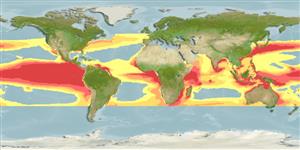Élasmobranches (requins et raies) (sharks and rays) >
Myliobatiformes (Stingrays) >
Mobulidae (Devilrays)
Etymology: tarapacana: Named for the Chilean province Tarapacà, where the type specimen was landed.
More on author: Philippi.
Environment: milieu / climate zone / profondeur / distribution range
Écologie
marin récifal; océanodrome (Ref. 51243); profondeur 0 - 1896 m (Ref. 117177), usually 0 - 20 m (Ref. 89972). Tropical; 50°N - 37°S, 180°W - 180°E (Ref. 114953)
Circumtropical, recorded from scattered localities. Western Atlantic: off Venezuela. Eastern Atlantic: Côte d'Ivoire and South Africa. Reported from Cape Verde (Ref. 34514). Indian Ocean: northwestern Red Sea and India. Western Pacific: Japan, Taiwan, and probably tropical Australia (Ref. 9911). Eastern Pacific: From Gulf of California to Chile (Ref. 130539).
Length at first maturity / Taille / Poids / Âge
Maturité: Lm 264.8 range ? - ? cm
Max length : 328 cm WD mâle / non sexé; (Ref. 58048); 305.2 cm WD (female); common length : 250 cm WD mâle / non sexé; (Ref. 9256); poids max. publié: 350.0 kg (Ref. 50641)
A large devil ray with a long head bearing short head fins; dorsal fin plain, and pectoral fins with strongly curved, swept-back tips; upper disc densely covered with small, pointed denticles and tail shorter than disc with no spine (Ref. 5578). Dark blue (Ref. 5578), olive-green to brownish above; ventral side white anteriorly, grey posteriorly, with an irregular but distinct line of demarcation (Ref. 11228). No caudal fin (Ref. 5578).
Body shape (shape guide): other.
Mostly oceanic, but also in coastal waters. Solitary, sometimes forms groups (Ref. 12951). Feeds on small fishes (Ref. 5578) and planktonic crustaceans (Ref. 9911). Ovoviviparous (Ref. 50449). Litter number 1 (Ref. 12951). Sometimes found stranded in beaches in temperate areas (Ref. 9911). Data on female max. length from Ref. 9256. Commonly caught in tuna gillnet and in harpoon fisheries. Utilized for its gill filter plates (very high value), meat, cartilage and skin (Ref. 58048).
Life cycle and mating behavior
Maturité | Reproduction | Frai | Œufs | Fécondité | Larves
Exhibit ovoviparity (aplacental viviparity), with embryos feeding initially on yolk, then receiving additional nourishment from the mother by indirect absorption of uterine fluid enriched with mucus, fat or protein through specialised structures (Ref. 50449).
McEachran, J.D. and G. Notarbartolo di Sciara, 1995. Mobulidae. Mantas, diablos. p. 759-764. In W. Fischer, F. Krupp, W. Schneider, C. Sommer, K.E. Carpenter and V. Niem (eds.) Guia FAO para Identification de Especies para los Fines de la Pesca. Pacifico Centro-Oriental. 3 Vols. FAO, Rome. (Ref. 9256)
Statut dans la liste rouge de l'IUCN (Ref. 130435: Version 2025-1)
Menace pour l'homme
Harmless
Utilisations par l'homme
Pêcheries: pêcheries vivrières
Outils
Articles particuliers
Télécharger en XML
Sources Internet
Estimates based on models
Preferred temperature (Réf.
123201): 19.4 - 28.9, mean 27.1 °C (based on 1824 cells).
Phylogenetic diversity index (Réf.
82804): PD
50 = 0.5039 [Uniqueness, from 0.5 = low to 2.0 = high].
Bayesian length-weight: a=0.01000 (0.00244 - 0.04107), b=3.04 (2.81 - 3.27), in cm total length, based on all LWR estimates for this body shape (Ref.
93245).
Niveau trophique (Réf.
69278): 3.8 ±0.59 se; based on food items.
Résilience (Réf.
120179): Très faible, temps minimum de doublement de population supérieur à 14 ans (Fec=1).
Fishing Vulnerability (Ref.
59153): Very high vulnerability (84 of 100).
🛈
